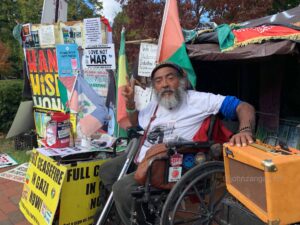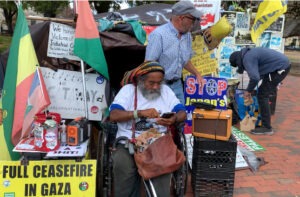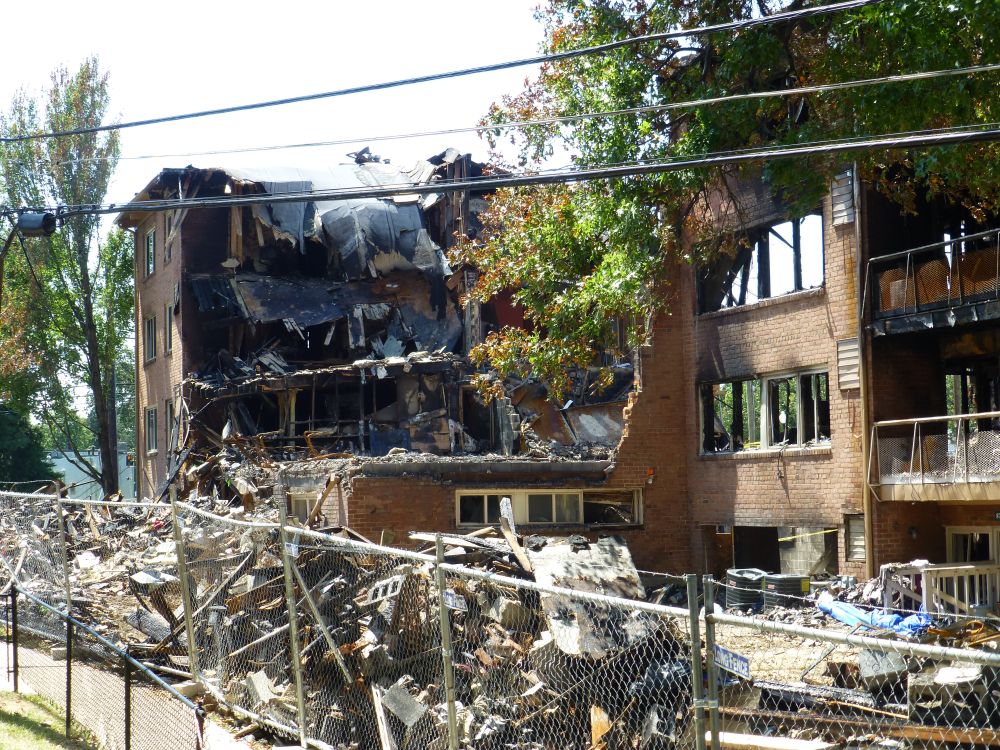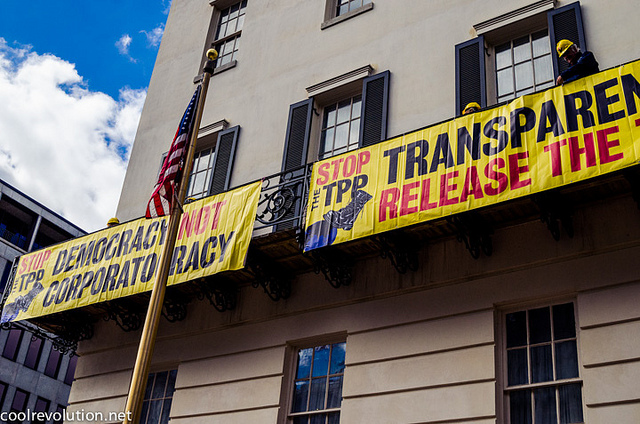
Washington DC—It is a sunny hot Saturday afternoon in mid-November at Lafayette Park as a steady line of tourists filter past the little white tent of the Peace Vigil outside the White House. The signs covering the tent reflect views contrary to everything the incoming administration stands for. The activists go about their daily rituals of preparing for a shift change. It’s 4 o’clock. Time seems to stand still.
Nearby the sounds of carpenter’s tools, hammers, drills, and saws, echo from the scaffolding while truck warning beepers sound across Pennsylvania Avenue as the temporary inauguration stands are slowly going up. The Peace Vigil tent has been moved back about 150 feet from its regular spot on the sidewalk. It temporarily resides just to the side of Andrew Jackson Statue, squeezed to a narrow part of the sidewalk where barely two can pass. Right on top of the tent’s regular resting place, a giant three-storied scaffolding is partially completed as carpenters and construction crews scamper like ants over its detail.
The temporary building will supposedly welcome a new president on January 20, 2025. But every activist at the Peace Vigil knows well—they won’t be welcoming him there on the sidewalk at the tent or during protests on the streets in the coming 4 years. As inauguration day approaches the entire park will be closed and the Peace Vigil will be forced to move further back to the edge of the park outside a 15-foot metal fence along Black Lives Matter Plaza.
No one at the Peace Vigil expected the reemergence of Trumpism in Washington. None of them saw this coming.
Phillipos, the Peace Vigil manager sits quietly pondering the future and silently wonders what is to come of the little tent. It’s symbolism in simplicity and minimalism is just as its creator, William Thomas envisioned. The 6-foot signs he created are long-gone, victims to weather, seasons and sun, but they have been replaced with exact replicas. One reads “Wanted: Wisdom and Honesty” while the other exhibits photographs of the Hiroshima and Nagasaki World War II nuclear bomb aftermaths. The signs are among the central themes to its message. They also challenge the willful lack of intent since President Reagan was elected, to end some of the most dire threats to humanity since the Peace Vigil’s inception in 1978 and approval of its first permit on June 4, 1981. Failure by the last seven presidents to tackle those issues has propelled it forward and made it the longest running continuous vigil for peace in the Americas—now 43 and a half years long.
Since then other issues have come to bear weight and are now intertwined with its main message and there are so many pressing issues that the activists have added signs that were handed to them after major protests over the years. The signs hang like rotting fruit from a tree, messages unharvested, bearing witness and truth against the combined procrastinations of all the presidencies since Reagan.
During the first Trump administration from 2017-2021, the Peace Vigil was a corner stone and both a beginning and ending point for many resistance protests. Washington DC swirled in chaos as a result of that administration, its indifference towards human rights, and worker’s struggles and its spirit spurred hundreds of protests, and created contentious social upheaval after trump unexpectedly stumbled into power in 2016. Under the Biden administration, some of the protesters left and the great volumes of surging humanity dwindled to a trickle, yet the Peace Vigil remained stoically toming the same drumbeat of issues the Biden administration discounted: Gaza, climate, greed, nuclear weapons, war, and many others.
On Saturday almost no-one was stopping to talk to the activists and the donation bucket was empty except for a few cents left by someone. Passersby seemed troubled and glum and in no mood to stop and talk about societal issues so soon after the election results just weeks before. Gone also were the multitudes of tourists, crack-pots, and odd-ball protesters who usually spring up on weekends and turn Pennsylvania into a strange cacophony of star seekers and personal grievances. A man with a cardboard box over his head, a woman reading scripture over a bullhorn begging people to repent, a man painted silver dancing to old tunes for donations, dancers and performers; protesters for Gaza, Indonesia, Ukraine and Iran freedoms, all were gone.
On Saturdays hundreds of visitors typically stop and talk to the weekend mainstay at the tent, Phillipos who is usually sitting straight across from the North Poritico of the White House. But today he was subdued and spoke queitly about the results of the 2024 election and it shows on his face and in his voice. He spoke with steady resolution about what he and the other vigilers are likely to face—the possibility that the 43 year old vigil may be forced to permanently shutdown and leave the park.
Although no one knows for certain if the Peace Vigil will be forced to go, there are many indicators of the chaos and tumult that is to come. The possibility of the tent being removed or raided looms as the liberal administration subsumes to what many are saying is an extremist in charge of an ideological agenda walking the country backwards and towards the last century.
For one, North Dakota Governor Doug Burgum, the nominee for Secretary of the Department of the Interior, the portion of government which oversees all the National Parks, including Lafayette Square Park, is a climate change denier and therefore an obstacle to renewable energy progress. A billionaire, he wants to lease much more public land for fossil fuels drilling and mineral extraction. Such environmental parasitism would practicably push the global climate emergency past the point of no return. And so it would not be much of a reach to sweep aside a small tent and a few activists.
He will also oversee the Park Police and this would certainly would mean some amount of pressure will be applied to remove the Peace Vigil tent even though it was authorized by a Court order to remain in the park. And even if it comes to outright removal Phillipos intends to keep coming back anyway. He pointed out that William Thomas and other activists stood on the sidewalk for years from 1978 to 1981 and fought countless court battles just for the right to be there; before the court finally agreed to issue a permanent permit so the Peace Vigil could remain.

Phillipos tells that during the early months of the first Trump administration an unidentified person came to him with an official offer on White House stationary promising a modest payment package to the Peace Vigil if the activists would agree to permanently take leave. Phillipos refused the offer but countered in writing on the back of the letter with a demand for several million—the value of which he calculated from all the labor activists put into the Peace Vigil over the (then) previous 35 years. The person left with their offer and Phillipos’ counter-offer but never returned.
Phillipos knows Trump doesn’t want the Peace Vigil to remain there. And it is likely he’ll do whatever it takes to remove the little tent and its signs for good from the red bricked sidewalk. And even though the Peace Vigil permit is enshrined in law, so long as the activists maintain it continuously without sleeping, when has the law ever been an impediment to Trump’s willfulness to disobey it? It is conceivable that every time he or any other President looks out the West Wing windows of the top floor of the White House it is the tent that he sees along with the two 6-foot signs, one on either side of the tent. And it is conceivable that he wants it gone no matter what the law says.
If there is a will to resist the coming policies of the incoming administration then this is and has been an example of what that will look like. Examples of ordinary people with little means standing up for rights of others are found here on the red bricks, not in the offices of bankers and CEOs who have paid millions for access through government back doors and certainly not from the desks of news pundits who fly down to Mar-a-Lago to smooth away ruffled feathers so they can continue their their coverage like the news staff of Morning Joe did last week.
It’s 4 o’clock and without discussion the activists prepare for a shift change. Craig arrives on time like an atomic clock and slips into the tent where he changes into warmer clothes he’ll need as night falls in the Autumn chill. Steve-O helps Phillipos gather his belongings and pushes his wheeled chair out from the front of the tent and towards his car. Craig quietly takes his seat and resumes the Peace Vigil evening watch. There are no thanks or goodbyes exchanged, no instructions or notes to pass on, just a resolve to continue doing their duties as they have done for years and will continue doing for as long as they can.
If there’s any chance that what remains of human rights here will remain, then many more like Phillipos and the activists of the Peace Vigil are going to have to put away their fear for the future and their doubt about what is to come and their reservations of what needs to be done about it and refuse to accept that it has to be this way. They’re going to have to resolve to fight for what they believe in and not pack up and go home.





